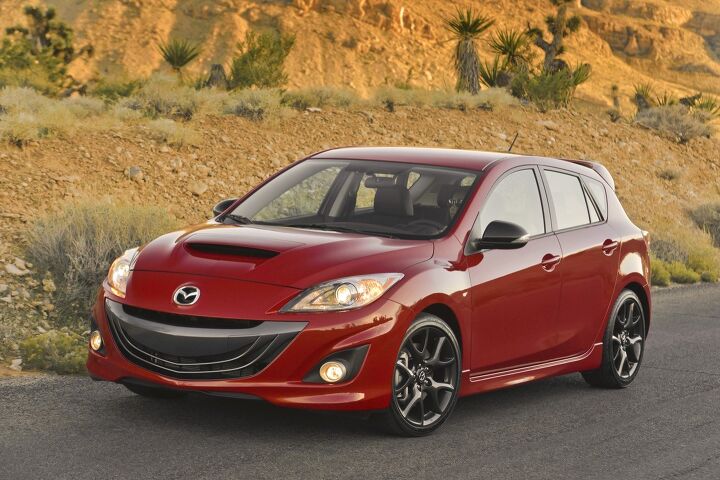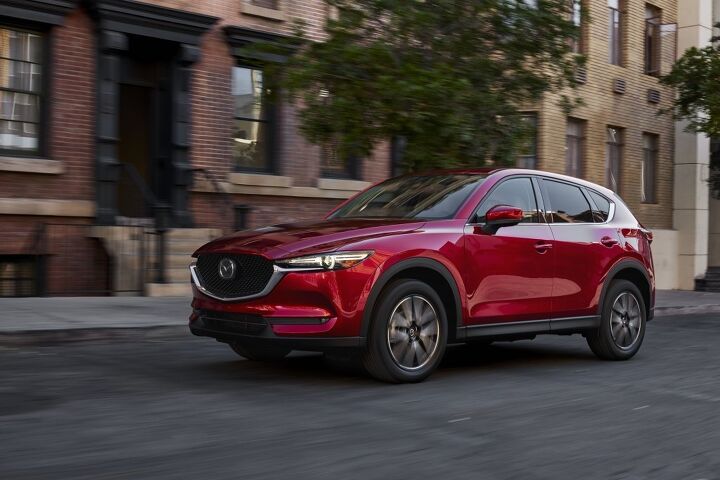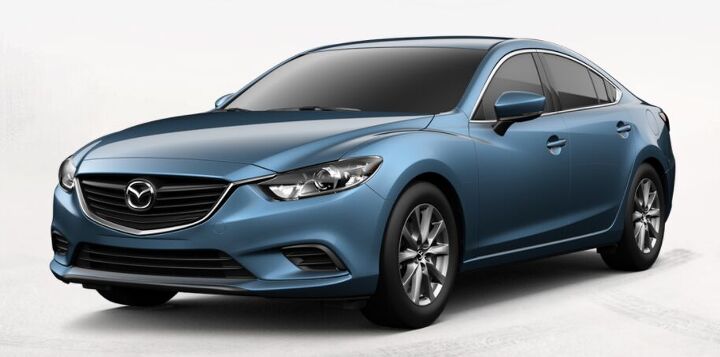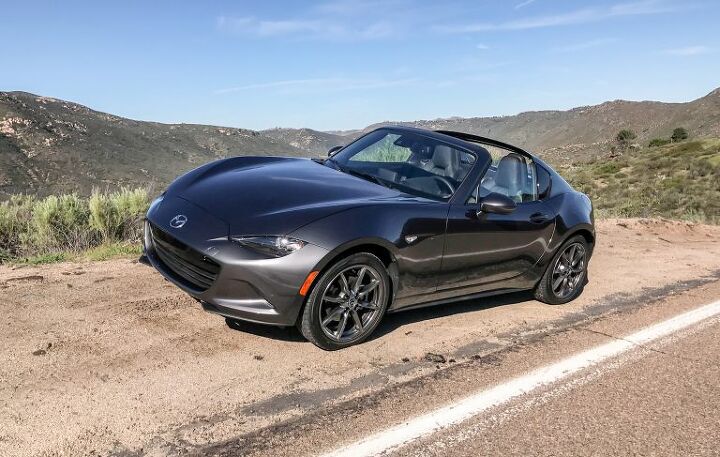#Mazda
Mazda Keeps Certifying the Mazda 2 With CARB, But Why?
It was January of 2015 and I was standing in a small venue in Montreal. The space was dark save some access lighting and red spotlights pointed at a sheet-covered car.
A few moments later, the sheet was pulled off, and Mazda Canada announced the 2016 Mazda 2 would be coming to The Great White North.
Eleven months later, Mazda Canada would reverse that decision, citing other all-new products — namely the CX-3 and MX-5 — requiring Mazda’s full attention. After all, the small automaker didn’t want to spread itself too thin, and it wasn’t like the previous-generation Mazda 2 set the sales charts on fire — on either side of the border.
In America, Mazda North America Operations had zero intention of selling the subcompact in any region other than Puerto Rico. Yet, year after year since the model went on sale in other global markets, Mazda continues to certify the Mazda 2’s emissions system with the California Air Resources Board, effectively making it eligible for retail sale in any of the 13 “CARB states” and District of Columbia.
Meanwhile, Mazda says it still has no intention to sell the Mazda 2 in America. What’s going on? We reached out to Mazda to get an answer.
QOTD: What to Do With Mazda?
Yesterday, Steph Willems asked in his Question of the Day what BMW should do with Mini and its lineup of identical-but-different vehicles almost nobody is buying. Since it seems like you’re quite eager to give brand strategy advice, let’s do it again today.
I want you to tell me what you’d do with Mazda, because its current PR line isn’t sitting well with me.
Mazda Wants 2 Percent U.S. Market Share, But Not Just Any Ol' 2 Percent Market Share
“I am not comfortable with 2 percent. I’m comfortable with a good 2 percent.”
– Masahiro Moro, President and CEO, Mazda North American Operations
Mazda’s U.S. market share fell to a 10-year low in 2016 and hasn’t noticeably recovered in the first four months of 2017. A small lineup with no presence in key segments limits Mazda’s chances of becoming a major automaker.
But Mazda doesn’t want to be a major automaker. Mazda wants to be a small but profitable automaker with profitable dealers and loyal buyers.
Mazda also wants to carry greater sway in the U.S. market than it does at the moment. Only slightly. Fractionally more. Marginally, almost imperceptibly more. Only 1.7 percent of the new vehicles sold in the United States are Mazdas. Mazda wants 2 percent, surely a reasonable and easily attainable goal.
But Mazda’s North American boss, Masahiro Moro, has no intention of jumping up to that 2-percent marker rashly or hastily.
Japanese Automakers Desperate to Spackle Gaps in Their Lineup
With trucks and crossovers dominating more of the market every month, Japanese automakers are making every effort to bring in new models that will satisfy consumer demands. Soundly constructed economy vehicles have long been the cornerstone of most Japanese nameplates but, with reliability improving among many brands and fuel efficiency being less important to consumers, we’re seeing a shift in the Far East.
Everyone from Toyota, Mazda, Honda, and Nissan have all expressed plans to focus on light trucks this year. Some Japanese brands are even banking on the continued growth of the segment to stage their comeback. “I think SUV sales will continue growing even if gas prices rise,” Mitsubishi CEO Osamu Masuko explained, citing the consumer appeal of higher seating and overall sense of safety. “The SUV segment is increasing its market share worldwide, and this is where we have long been strong,” he said. “So, we will continue to make full use of this technology.”
Mazda Makes a Bet on Popularity of Upcoming CX-5 Diesel
Diesel power has traditionally proved a tough sell in the United States, at least among light-vehicle buyers. If it doesn’t belong on a worksite, chances are a vehicle’s engine choices have remained gasoline-only since the model’s debut.
While the high-mileage technology suffered a black, sooty eye from the Volkswagen affair, several automakers are gambling on Americans want of higher torque figures and improved fuel economy — the rosy promises of diesel motivation. Mazda, the only automaker without a hybrid or electric vehicle in its stable, plans to add a diesel CX-5 to its gas-only U.S. fleet later this year.
The automaker knows exactly how many it wants Americans to buy. If this litmus test on wheels reaches the pre-determined mark, expect to see more zoom-zoom diesels appearing in local showrooms.
Where's Mazdaspeed? Is Mazda's Premium Push Stifling Performance?
My, how time flies. Nearly half a decade has passed since Mazda, undoubtedly an automaker that believes in performance, last offered a Mazdaspeed product.
Not since 2004 and 2005, when 5,142 Mazdaspeed MX-5s were delivered in the United States market, has Mazda’s most obvious performance car been available in a power-up version.
Not since the first-generation Mazda 6’s 2005/2006 Mazdaspeed tenure has Mazda’s midsize sedan been offered in performance guise.
And after following up one of the best-handling front-wheel-drive cars of its era, the Mazdaspeed Protege, with the Mazdaspeed3 in 2007 and another in 2010, Mazda hasn’t had a hot hatch contender to battle the Volkswagen Golf GTI and R, Ford’s ST and RS models, the Honda Civic Si (and now Type R), the Subaru WRX, and Mini’s Cooper S since 2013.
So, is Mazdaspeed dead?
Mazda Appoints Chief Marketing Officer in Upmarket Push
Mazda’s North American Operations has named Dino Bernacchi as its chief marketing officer, a position created specifically to aid the automaker in establishing itself as a premium brand.
The manufacturer has taken steps to ditch its economical heritage for nearly a year as it pushes upmarket. Model redesigns have followed a cohesive, sleek trend while the company zeroes in on a future “premium, pricey model” to secure its new identity.
Until then, image is everything for Mazda. The brand doesn’t seem interested in swapping over to a luxury-focused lineup or changing its production philosophy. While Mazda had what was arguably the most aesthetically appealing booth at the New York auto show (even if Porsche and Volvo had the better snacks), most of its vehicles still start below $25,000.
Ace of Base: 2017 Mazda MX-5 Miata Sport
Sometimes a manufacturer churns out a base model in which it might be more prudent to spend one’s extra cash on aftermarket upgrades and not a more expensive trim. Here’s a candidate.
Many songs of praise have been penned and much digital ink spilled of Mazda’s rear-wheel drive, two-seat roadster. From the original version in 1990 to the current fourth-gen model, Mazda has always managed to keep a lid on cost and weight, two things which generally spiral out of control in both successive iterations of a popular vehicle and my own personal lifestyle as I age.
A total of $5,150 separates the base MX-5 Sport from the top rung Grand Touring model. Is that sum of cash better spent on DIY upgrades? Or should buyers spring for the high-zoot MX-5? Let’s find out.
Piston Slap: Zoom, Zoom … Wander?
TTAC Commentator AbqJay writes:
A couple of months ago I bought a slightly used 2016 Mazda 6 Grand Touring with 18,000 miles. The car is my wife’s daily driver; I drive it about once a week, and for longer trips, such as a jaunt I took from our home in Albuquerque to southern California in December. It’s hard to believe, but this is my first wrong-wheel drive car. The Mazda 6 is roomy, has decent power, gets fabulous mileage, and has an interior filled with creamy leatherette seating and trim, and soothing blue LED lighting. Since no one wants to buy this car, we got a great deal on it. So far so good.
Then I drove it to Cali.
On the drive, I noticed the steering is heavy. As in really heavy. As in my wrists hurt after driving it for about 20 minutes on the interstate. It feels like I am wrestling with it, even though the steering appears to be dead center.
Ace of Base: 2017 Mazda 6 Sport
This is How the Global Mazda MX-5 Cup Car Is Built
The Global Mazda MX-5 Cup car is one of the most affordable, ready-to-race cars on the market today. The racer starts as a fourth-generation Mazda MX-5 and receives over 250 changes to become track ready. Mazda wanted the cars to be built to a single spec, so it tapped Long Road Racing to be the sole builder of the car.
I paid them a visit to see just what goes into building these race-ready roadsters.
Not Many People Will Get to Enjoy the Mazda MX-5's Removable Hardtop
Nor should they, really. Mazda’s MX-5 Miata already offers the option of an aluminum-and-steel overcast with its delightfully gimmicky and functional RF variant.
Still, past MX-5 owners often shelled out for a simple and attractive fiberglass top to accompany their factory cloth top. You’d often find it stashed in the garage next to the lawn mower. So popular were these aftermarket accessories, Mazda saw fit to offer customers the all-weather confidence and convenience of a retractable hardtop, starting in 2006. With the RF, it chose a different way of letting the sun shine in.
Well, there’s now a new removable top available to MX-5 owners, but you’ll never see it on the street.
2017 Mazda MX-5 RF First Drive Review - Adding Balance
Let’s get right to it. Retractable hardtop MX-5 owners will pay a 113-pound penalty for their motorized, targa-topped fun. 113 pounds. Mazda engineers and marketers do not take that sum lightly. But we can, because unless you are stripping down your Miata for competitive track work — in which case you will select the softtop anyway — you will not feel the difference.
The hardtop does absolutely nothing to diminish the balanced, driver focused, analog pleasure of the fourth generation MX-5. And for the purists, consider your baby may one day only be visible in the rearview mirror if Mazda can not expand the audience for this little icon.
2017 Mazda CX-5 First Drive Review - Less is More
Mazda wants you to know its 2017 CX-5 is more than just another compact crossover. Not in terms of size, power, or price, but in its transcendent experience. Media introductions are often an exploration into the esoterica of automotive design, and this launch is no different — except for a refreshing dose of substance sprinkled over a focused, if understated, redesign.
Compact crossovers recently eclipsed full-size trucks as the largest automotive segment. And right on cue, CX-5 is Mazda’s best-selling vehicle, accounting for 38 percent of its U.S. sales last year. Not only that, but it was Mazda’s fastest nameplate to earn one million sales worldwide. It’s thus no shock that as important as this little ute has become to Mazda, its first generation lasted just five years. Nor is it a surprise that its well received first generation is followed by an evolutionary and not a revolutionary second gen, with a diesel on the way to further extend its reach.
If it ain’t broke, tweak it.
Don't Call The Mazda CX-3 A Flop - Yet
Operating in the burgeoning subcompact crossover market that’s soon to welcome new entries from Toyota and Ford, the still fresh Mazda CX-3 is already suffering from declining sales.
And the CX-3 is not declining from a particularly high and lofty point achieved earlier in its short lifecycle. There was no hot start for the Mazda CX-3, no early high-volume response to hyped-up demand from which sales would inevitably decrease.
Over the last three months, U.S. sales of the Mazda CX-3’s direct competitors have grown 21 percent, year-over-year. Yet sales of the CX-3 during the same period have declined 4 percent.
The Mazda CX-3 is a new model, only on sale for a year and a half. It’s attractive and highly regarded by reviewers. Yet sales are slowing at the very same time as sales of its competitors are flourishing.
Mazda doesn’t intend to chase volume for volume’s sake, but Mazda does intend to get the CX-3 product mix right before the CX-3 is labelled a flop.






























Recent Comments